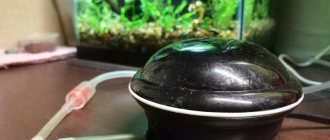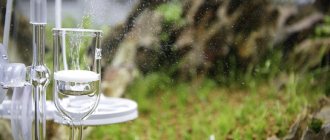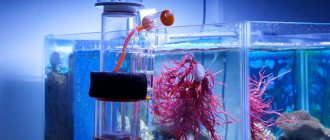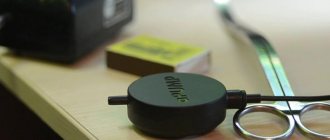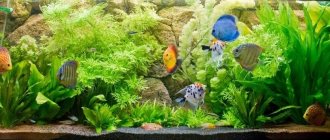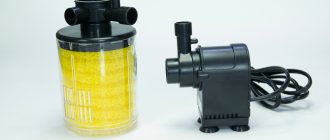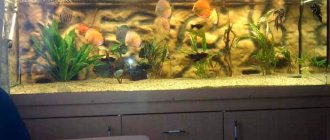The most convenient way to make this lighting is built into the lid of the aquarium, and this can be done in several ways, both under ordinary light bulbs with an E27 base, and under fluorescent tubes or LED strip.
However, before you start lighting, you need to make this very cover out of something. Let's look at three options for aquarium covers, and you can choose the most suitable one for yourself.
The first option is the simplest and most common among aquarists and involves the use of PVC panels, or the so-called lining, as a frame.
We will assemble the second cover based on sheets of foamed PVC. With their help, you can make a high-quality lid for both large and small volumes.
Well, the third, open type for herbalists on polypropylene pipes.
Cover frame made of PVC panel
PVC panels are the most popular material and there are several reasons for this:
- sufficient structural rigidity
- budget
- the material is easy to process and cut with a regular stationery knife
And the panel inside is hollow, which reduces the total weight that will be on top of the aquarium.
The size of the lid directly depends on the volume of the aquarium. If the dimensions and width are large, it will have to be made of three components - the front wall, the middle, the back wall. Well, plus the sides.
All this fits together easily and is assembled with glue like a construction set. Let's take a closer look at the manufacturing process of the option for large-volume containers.
To ensure better frame rigidity, it is recommended to use a double panel (simply glue one on top of the other).
In order for the lid to fit on the glass, a U-shaped groove must be cut along the edges of the PVC panel. With this groove, the front and back sides will seem to fit onto the walls of the aquarium.
Next we need to decide on the height of our cover. Do not forget that it will have a built-in backlight, which for some reptiles (turtles) must be located strictly at a certain distance from the water or island.
The bend should be at the marked height. To make it without damaging the outer layer of PVC, cut a strip of at least 1 cm wide on the inside of the front side with a stationery knife. No need to cut through!
Next, bend the lid at this point at an angle of 90 degrees and temporarily fix it in this position with masking tape.
Check the right angle with a square.
To give the lid a permanent shape, glue small plastic corners in the middle of the fold. They are made from rigid PVC plastic (this is not the same hollow panel!).
To do this, the plastic is pressed in the middle with a screwdriver, heated with a hot air gun and carefully bent at a right angle.
You can also buy factory plastic corners. They are sold in the same construction stores.
Glue the corners with superglue in several places on the bent lid.
Then apply silicone glue or cosmofen liberally to the previously cut fold.
It reliably seals any joints and slots.
It protects against the formation of mold or mildew in these areas.
We proceed to attaching the middle (straight) part of the lid. Cut it to the desired width and glue it to the previously bent piece.
To do this, wide grooves must be cut in the plastic along the edges of the two halves. Lubricate them with glue and place the halves together.
As a result, you should end up with one single design. While the glue dries, secure the workpieces with tape.
All that remains is to build the back wall. It is done similarly to the front one.
- U-shaped groove along the edge for installation in aquarium glass
- bend at an angle of 90 degrees according to the height of the lid
- inserting the central part
To more securely fix the middle half of the lid and create stiffening ribs, glue rectangular PVC inserts on the inside.
Materials
Creating such an element with your own hands is not a complicated process, but it is labor-intensive and requires a thorough approach. To begin with, the material for the walls and base is selected. You can choose cardboard, but it is not only not durable, but also unstable in the face of moisture, which it will come into contact with one way or another under these conditions. Therefore, the cardboard cover can only be considered as a temporary shelter.
A much more suitable option is a plastic panel with a thickness of 5 mm, preferably made of foamed polyvinyl chloride (PVC). It is distinguished by good rigidity, water resistance and lightness.
Tools and consumables:
- a regular stationery knife is suitable for cutting out pieces of plastic;
- plastic quickly sticks together with instant glue or PVA, but you need to work with them in a well-ventilated room. PVA, moreover, takes time to dry and set firmly;
- silicone sealant for processing joints and seams, as well as a syringe for squeezing it out;
- rubber gloves to protect hands;
- large ruler or tape measure;
- pencil (you can use a marker, but it is either strongly absorbed into the material or smeared on it);
- 4 plastic corners (available at any hardware store);
- acrylic paint or self-adhesive wallpaper.
For greater strength and rigidity, you can use aluminum corners when creating the lid. In addition, the work may require washers, boots, screws, electrical wires, lamps and electrical tape if you plan to make a lid with lighting.
End caps
It remains to close two ends. To do this, check their width on each side of the aquarium.
Please note that sometimes these sizes may differ by a couple of millimeters. Therefore, you need to measure on both sides, and not make them the same initially.
Measure rectangular blanks on PVC plastic and cut them to these dimensions. Next, use a knife to cut off all the partitions made of PVC plastic along the edges. Something like this.
The side walls should seem to fit into the lid itself and only then stick to it.
For rigidity, we again use plastic corners.
We seal all joints with glue and sealant. The finished lid design will look like this from the inside and outside.
To create a more attractive look, paint it in dark colors.
Or cover it with dark decorative film. It will look completely different.
It is better to apply the paint in several layers, otherwise the PVC panel may show through when the lights are turned on.
Ready-made options
Of the ready-made structures, we recommend the one known in Russia. It offers customers a variety of options - rectangular and panoramic aquariums. Available in small ones - 40x25 cm, and designed for a large tank - 120x40 cm, and rare 100x40 cm. There is almost any lid for a panoramic aquarium - from 50x30 to 120x40 cm. Color is not only black or gray, but also in the tone of oak, walnut, alder and others.
produces simple, inexpensive designs with a five-year warranty. engages in custom-made lid manufacturing, creating designs of any complexity.
How to get rid of condensation?
Many aquarists recommend gluing the inside of the lid not just with foil, but with a special thermal insulation material with a reflective coating.
Similar material is glued behind the radiator or placed under heated floors.
What does it give? First, the reflection of light.
But most importantly, this backing protects against heavy condensation on the inner surface of the lid.
It acts as an insulator against temperature changes, so that in any season of operation of the aquarium (spring or autumn), moisture will not accumulate on the surface of the lid.
Otherwise, situations often arise when the heating has not yet been turned on, the water in the aquarium is warm, but the room is cool. Hello, condensation and failure of electrics or light bulbs.
Installation and connection of lighting lamps
Let's move on to lighting installation. First we will do it using ordinary LED light bulbs.
To turn the backlight on and off, you will need two switches. Don’t take bulky indoor two-keyboards; small “buttons” look much more beautiful.
The current in the circuit will be insignificant, so they will withstand such a small load.
The bulbs should be placed evenly over the area - some along the edges of the lid, the rest in the center. The outer ones will be turned on from one button, the central ones from the other.
Ceramic sockets will be needed for each light bulb. How to attach them to the lid? The best option here is clips for plastic pipes. For E27 cartridges they will fit 32mm.
The clip itself also needs to be screwed to the inner wall of the lid. If you used a single PVC panel rather than a double panel, you will have to make square platforms. Otherwise, the screw will pierce the wall.
Cut out square blanks from the same PVC plastic as the lid, and glue them to the inside, where the light bulbs will be.
Next, screw the clips into these places using small screws.
Insert a ShVVP wire 2*0.5 into each cartridge. Read how to properly connect a light bulb socket in a separate article.
The outer sockets are connected with one wire, the central ones with another. To ensure that the conductors remain intact when connecting several light bulbs, do not cut their copper strands, but simply remove the outer insulation and place a ring under the screw.
This parallel connection of several light bulbs in a row is widely used in the manufacture of makeup mirrors.
Cartridges with charged wires are inserted into the clip holder and stay there perfectly.
When connecting wires to the switch, do not forget that it is the phase conductors that must break through it. Zero goes directly to the paws, without the participation of a switch.
Small holes are cut out for the microswitches in a convenient place on the cover, where they are glued.
By connecting all ends, check the functionality of the backlight. To prevent the wires from hanging or dangling, glue them to the outside of the cover.
They can also be hidden in a separate box or cable channel.
Place the lid on the top of the aquarium and turn on the light. Don't forget to cut holes in the plastic for cables and hoses.
Preparing for work
Making your own lid is easy. The main thing is to choose the right material, calculate its quantity and dimensions of the finished product so that it sits tightly on the container and can withstand the load.
You will first need to take measurements, accurately taking the parameters of each wall, as well as the desired height. In order not to get confused in the future, it is better to make a drawing, which will indicate in detail and clearly which segment will go where.
Also important is the form itself. She can be anything. If this is a lid for a corner aquarium, then, accordingly, you need to calculate how it will sit. But even for a standard rectangular container you need to think through everything carefully, namely:
- How the walls will contact the glass;
- Are ventilation holes necessary?
- Will there be a need for doors through which access to the aquarium will be simplified for feeding, care, etc.;
- Where the holes for the filter, compressor and other equipment will be located.
In addition, for manufacturing you will need certain accessories and tools:
- Roulette;
- Pencil;
- Stationery knife;
- The material itself (PVC, laminate);
- Corners;
- Glue (optionally, liquid nails).
We recommend reading the article: How to make an aquarium with your own hands
Holes in the aquarium lid
What about feeding and maintaining the aquarium? There are several ways.
The simplest one is to remove the entire lid from the aquarium each time and put it aside. Agree, not the best option.
Another way is to cut one or more hatches and attach a handle to them. They are made either removable or on canopies.
It may be suitable for feeding, but for cleaning filters or glass it is not very convenient.
Therefore, it is best to use canopies through which the entire lid, like on a chest of drawers, will rise and fall. How to do it?
Most often, an aquarium at home is placed close to one of the walls in the room. So, insert a wooden strip between the aquarium and the wall. Its thickness should be equal to the distance from the aquarium to the wall.
The piano hinges are screwed onto this rail, and on the other hand, the lid itself is attached to small screws.
So that this structure can be completely removed if necessary, the wooden plank should not be attached to the wall rigidly, but hang on hinges. These are used for wall cabinets.
To fix the cover in the upper position, install a furniture gas lift in the side edge. It costs a penny and is not afraid of moisture.
Its only weak points are two fastenings. They need to be treated with sealant, otherwise they will rust.
What other holes are needed in the lid? For example, a built-in round thermometer would look good on the front side.
There must be holes for ventilation.
As a decoration, they are well enhanced by the body of ceiling lamps.
Cutouts are also made on the sides and back.
What does this give? When the lid is closed, fresh air enters through them and convection currents through the upper holes expel it out.
This way the lamps do not overheat, the water does not heat up above normal and natural ventilation is ensured.
Purpose
Aquarium lids serve not only as decorative items. They perform a number of useful functions, without which it is difficult to provide underwater inhabitants with the necessary conditions:
- Significantly reduce the rate of liquid evaporation. The period between top-ups increases.
- They serve as a reliable protective barrier against foreign objects entering the tank.
- Protects against pets, especially curious cat paws. Relevant for houses where parrots, cats, and dogs are kept.
- They are supplemented with the necessary elements, including lighting fixtures, accessories for a filter and an aerator.
- They prevent fish from accidentally jumping out of the aquarium, keeping them alive.
- Allows you to maintain the desired temperature.
Thus, the lid helps maintain the established balance of the ecosystem and increases the safety of the inhabitants of the aquarium.
Aquarium lighting diagram with fluorescent and LED tubes
The second lighting option is to make the same lid, but instead of cartridges, attach holders for T4, T5, T8 fluorescent tubes inside.
Connect them in parallel with each other, and lead the wires to the starters. It is most convenient to connect lamps at the end through special waterproof caps.
The connection diagram will depend on your electronic ballast. Look and check it on the device body.
Fluorescent lighting implies the presence of special chokes or starters. These are such heavy rectangular boxes. The power wires first go into them, and only then disperse through the lamps.
Mount these triggers on the side or back of the lid so that it is not visible to others and does not detract from the appearance of the aquarium.
You can find completely sealed blocks that are not afraid of damp places, and place them from the inside. But again, the connection points of the conductors will have to be reliably sealed with some kind of adhesive.
The wiring diagram for an aquarium lighting with four fluorescent lamps will look like this.
Do not forget that you need to connect the lighting in the aquarium through a differential circuit breaker or RCD in order to protect yourself and your pets in case of an unexpected current leak.
If you are afraid of a large number of wires, then it is better to install not bare T-8, T-5 tubes, but LPO lamps ready for them with built-in electronic ballasts.
For each such lamp you will need to install only one cable. Four tubes - four cables.
They also sell special jumpers for them.
By using them, you will generally have only two cables coming from the push-button switches, and no cobwebs from a bunch of wires.
Instead of obsolete fluorescent tubes, it is better to use LED ones. In this case, you just need to connect the phase and zero on each side of such a tube.
Old type LB lamps can be very easily converted to LED ones. Read more about this in a separate article.
Combined lighting can be made for small tubes. Fix the tubes in the middle of the lid, and install two LED bulbs at the edges.
You cut two hatches on the canopies for the light bulbs. When the hatches are opened, the bulbs will come out.
Fluorescent lighting can be connected to one switch, and an LED to another.
But do not overdo it with the number of lamps and the brightness of the backlight.
Aquarium lighting with LED strip
The third lighting option is a moisture-resistant LED strip with a degree of protection IP65.
There is no need for cartridges, T-8, T-5 tubes, or chokes, but you will need a 12V power supply.
Sealed, waterproof power supplies are mounted both outside and inside the cover. Look at the dimensions of the aquarium.
A voltage of 220V is supplied to the block, and the 12V output through two conductors (“+” and “-“) goes to the contact pads of the tape.
Soldering points are sealed with hot-melt adhesive.
Read about all the nuances and connection diagrams for LED strip in separate articles.
What is good about LED strip? Firstly, low voltage. Secondly, if absolutely necessary, such lighting can be connected even from batteries, without an outlet, without 220V voltage and unnecessary wires.
At the same time, it works great on high-capacity 18650 batteries for quite a long time.
Please note that you cannot simply stick a powerful LED strip onto the surface of the lid. Otherwise, it will serve you for a couple of months and will burn out from overheating.
Special aluminum profiles are produced for such tapes. They play the role of a cooling radiator.
You attach such a profile to the lid (using small screws or hot glue), and then glue the backlight to it. In this form, the LED strip will last its entire warranty period.
By the way, a life hack for those who want to increase the backlight intensity without significant costs. Typically, an LED strip is glued in a straight line onto a flat surface and thus the stated number of lumens is obtained from it.
But you can do it a little differently. Take a plastic tube and wrap the tape around it in a spiral.
As you understand, for the same length of the cover, in this case you will use much more backlight, which means its brightness will increase.
The tube itself is attached to the lid using clips. In the presence of a reflective substrate, quite bright illumination comes out.
If possible, instead of a plastic tube, you can choose an aluminum one. This will significantly improve heat dissipation from heated diodes and increase their service life.
Why is it better to make it yourself?
- Aquarists purchase tanks of different sizes for fish. But not a single standard model will fit the original container of an unusual shape.
- The standard one is equipped with only two electric lamps. This is not always enough to fully illuminate the tank. The lack of light causes the fish to experience discomfort.
- Factory models mainly consist of several parts. Every time you change the water or clean the tank, you will have to disassemble it, which is not very convenient.
- The lid is located very low above the water level. Then the lamps begin to heat it up - by five degrees or more. And also, due to the low location of the structure, condensation begins to form.
- Standard models have too narrow compartments for tubes and wires. Therefore, it is difficult to install a mechanism that takes water for purification.
- Factory models are not equipped with ventilation systems. And so that the fish do not suffer due to lack of oxygen, you will have to periodically open the aquarium.
Based on these reasons, we can conclude: it is better to make the roof for the house of the wards yourself.
Foamed PVC cover
The second material for making the lid is foamed PVC sheet, not to be confused with hollow PVC lining. Take a thickness of at least 8mm.
It is sold in wide rectangular sheets.
You can make either a one-piece structure or one consisting of two parts.
The front part of the lid is opening, the back part is fixed.
On the front part, to create greater rigidity, it is better to use two sheets glued together rather than one. This is where the loops will be twisted to open this half.
For large sizes, on the second non-removable part, again for the stiffening rib, screw a simple aluminum corner along the entire length. These are usually used on door thresholds.
Along the entire perimeter, at the joints of the horizontal and vertical parts of the lid, glue rectangular or triangular inserts made of the same thick-walled foamed PVC.
These sides act as supports with which the lid will be installed on the glass of the aquarium. Therefore, it is initially made slightly wider than the container itself.
That is, to find out the dimensions of the lid, take the length or width of the aquarium, add to them two wall thicknesses of PVC plastic, plus leave 4-5mm for play.
In this case, the lid will easily be put on and removed over your jar.
The material can be easily cut with a utility knife and glued with superglue. All joints and seams are filled with pouring cosmofen.
Cut technological holes according to your own considerations, according to the above recommendations.
To add beauty, after assembling the frame, all that remains is to cover the lid with decorative film. Don't forget about the reflective material on the inside.
Connecting electrical and lighting is similar to the previously discussed options.

